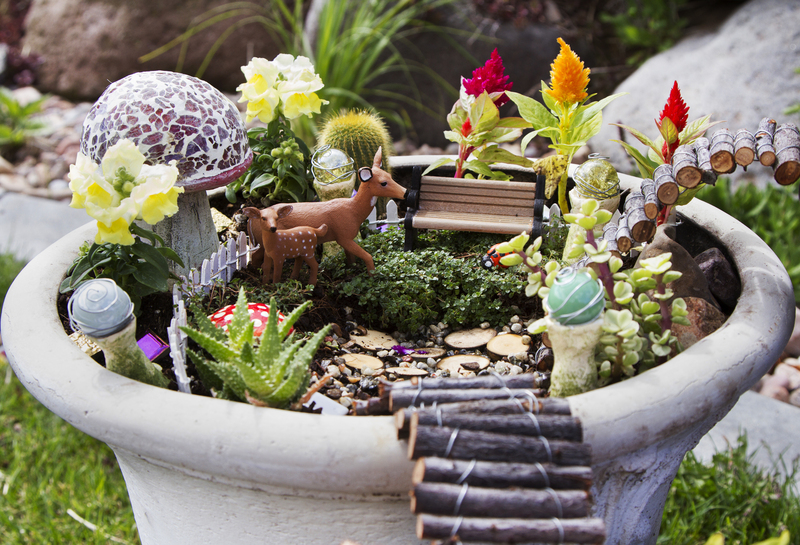From Chaos to Calm: Redesigning a Neglected Garden
Posted on 05/09/2025
From Chaos to Calm: Redesigning a Neglected Garden
Have you glanced out your window recently, only to find your outdoor space cluttered, overgrown, and uninviting? Don't despair-- transforming a neglected garden into a calm, beautiful oasis is not only achievable but deeply rewarding. In this comprehensive guide, we'll walk you through everything you need to know about revamping a chaotic backyard into a serene retreat, no matter your budget or skill level.

Why Redesigning a Neglected Garden Matters
A garden is more than just an extension of your home. It's a sanctuary where you can reconnect with nature, unwind after a long day, or entertain friends and family. A tidy, thoughtfully-designed outdoor space can increase your property value, improve your wellbeing, and support local biodiversity.
Benefits of Transforming an Overgrown Garden
- Enhanced Aesthetics: A well-maintained garden boosts curb appeal and complements your home's style.
- Health and Wellbeing: Time spent in a tranquil garden has been shown to reduce stress, improve mood, and encourage physical activity.
- Environmental Impact: Revitalizing your plot can support pollinators and create a mini-ecosystem for urban wildlife.
- Space Utilization: Properly planned gardens maximize usable space, providing areas for play, relaxation, and even growing your own food.
Assessing the Starting Point
Before launching into your garden re-design, take time to assess what you already have. This step helps save money, time, and prevents unnecessary waste.
Inspect and Inventory
- Identify Existing Features: Note mature trees, established shrubs, or original hardscaping that can be incorporated into the new plan.
- Analyze Problems: Check for drainage issues, compacted soil, weed infestations, or hazardous elements such as broken fences.
- Resource Review: List out tools, usable materials (like bricks, pots, stones), and plants worth saving or transplanting.
Visual Documentation
- Photograph the Garden: Take before-photos from various angles. These help track progress and keep your end goals in sight.
- Sketch a Rough Plan: Even a simple map shows key structures, sunny and shaded spots, and potential problem areas.
Setting Your Garden Redesign Goals
What does your dream garden look like? Setting clear objectives ensures you stay focused and motivated throughout the process.
- Functionality: Do you want an entertaining zone, a children's play area, or a peaceful meditation corner?
- Maintenance Level: Choose between low-maintenance designs or lush, high-effort plantings.
- Style and Theme: Contemporary, cottage, wildlife-friendly, or drought-tolerant?
- Budget: Establish what you can realistically invest, and consider phasing larger projects over time.
Clearing the Canvas: Initial Cleanup
Before actual redesign work starts, tackle the chaos head-on. Rolling up your sleeves and transforming disorderly spaces into clean slates is the first major leap toward your garden sanctuary.
Step-By-Step Cleanup Tactics
- Remove Waste: Bag up litter, plastics, broken pots, dead wood, and any hazardous debris.
- Cut Back Overgrowth: Prune overgrown bushes, trees, and hedges to manageable sizes.
- Weed Thoroughly: Uproot invasive plants--root and all--and consider installing weed barriers in the future.
- Mow and Edge: A freshly-mown lawn instantly lifts the whole space and edges create clean lines.
- Soil Care: Loosen compacted areas with a fork and top-dress with organic compost for improved vitality.
Planning the Redesign: Layout and Structure
A successful garden transformation blends structure, functionality, and beauty. Here's how to plan a layout that soothes the soul and stands the test of time.
Design Principles for a Calming Garden
- Define Zones: Assign areas for relaxing, dining, play, and planting. Use structural elements like hedges or paths to mark boundaries.
- Balance Hard and Soft Landscaping: Combine patios, decking, or gravel with lush beds or lawns for variety and interest.
- Prioritize Flow: Paths, stepping-stones, or gravel tracks should encourage gentle movement and exploration.
- Maintain Cohesion: Limit color palettes and material types for a harmonious feel.
- Embrace Layering: Use trees, shrubs, perennials, and groundcovers to create a sense of depth and tranquility.
Incorporating Existing Features
- Mature Trees: Frame focal points, provide shade, and encourage wildlife--don't be too hasty to remove old favorites.
- Reclaimed Materials: Turn weathered bricks, stones, or timbers into paths, raised beds, or edging for rustic charm.
Choosing the Right Plants for Your Redesign
The right plant choices set the tone for your new garden. Aim for year-round interest, low maintenance, and plants that thrive in your local climate.
Elements for a Calm and Serene Garden
- Soft Grasses and Groundcovers: Feather Reed Grass, Fountain Grass, or creeping Thymes create gentle movement and texture.
- Evergreen Structure: Boxwood balls, conifers, or winter-flowering heather look good in every season.
- Flowering Shrubs: Hydrangeas, camellias, and azaleas add color and lushness.
- Fragrant Selections: Lavender, rosemary, jasmine, and scented roses bring soothing aromatics.
- Wildlife-Friendly Blooms: Alliums, foxgloves, and buddleia attract butterflies and bees for a lively, natural feel.
- Tree Choices: Amelanchier, birch, or Japanese maple are stylish yet manageable for smaller plots.
Practical Planting Tips
- Go for Groups: Plant perennials in odd-numbered clusters for greater visual impact.
- Plan for Year-Round Beauty: Mix early bulbs, summer perennials, autumn grasses, and winter evergreens.
- Think of Pollinators: Integrate native flowers and nectar-rich species.
Adding Calming Features and Focal Points
To shift your garden from chaos to calm, add design elements that anchor the eye and invite relaxation.
- Water Features: Install a pond, trickling fountain, or birdbath for gentle sound and reflected light.
- Seating Areas: Create inviting nooks with benches, swings, or hammocks for contemplation.
- Paths and Arbors: Guide movement through the garden with winding paths, trellises, or pergolas draped in climbers.
- Garden Lighting: Soft solar or LED lights extend enjoyment into the evening and highlight key features.
- Artwork and Ornaments: Choose subtle sculptures, wind chimes, or mosaic stepping stones for personality and whimsy.
Soil Health and Sustainability
A truly restorative garden begins below ground. Building healthy soil not only boosts plant performance but also contributes to environmental resilience.
Building Better Soil
- Compost Regularly: Incorporate homemade or purchased compost to enrich the soil naturally.
- Mulch Generously: Organic mulch suppresses weeds, locks in moisture, and protects soil life.
- Practice No-Dig Gardening: Minimize disturbance to preserve beneficial soil microbes and structure.
Sustainable Practices
- Rainwater Harvesting: Install water butts to collect roof runoff and save on water bills.
- Plant Native Species: Native plants require less water and provide essential support for local wildlife.
- Limit Chemicals: Reduce or eliminate synthetic fertilizers and pesticides, opting for natural solutions.
Maintaining Calm: Garden Upkeep and Enjoyment
The transformation from chaos to calm endures only with consistent, mindful care. Maintenance need not be overwhelming--integrate simple routines and savor the process.
Essential Garden Maintenance Tasks
- Regular Watering: Especially vital for new plantings and during dry spells.
- Mulching and Feeding: Top up mulch annually, and use slow-release organic fertilizers as needed.
- Pruning and Deadheading: Shape hedges, remove faded flowers, and keep growth controlled.
- Pest and Weed Monitoring: Deal with problems early using eco-friendly methods.
Making the Most of Your Revitalized Space
- Entertain Outdoors: Host gatherings and meals among flowers and foliage.
- Wildlife Watching: Set up feeders or bat boxes and enjoy the visiting creatures your new oasis supports.
- Meditate or Practice Yoga: Dedicate time for mindfulness in your peaceful retreat.
Before and After: Real-Life Success Stories
- Katie's Urban Paradise: "Our city backyard was a mess of brambles and concrete. With careful clearing, raised beds, and a simple patio, it's now a haven for friends and family."
- Jasmine's Wildlife Sanctuary: "By planting foxgloves, lavender, and a mini pond, we've seen butterflies, bees, and birds return in just one summer."
- Mark's Minimalist Escape: "I focused on geometric beds, smooth gravel, and box hedging for a Zen-like calm. Maintenance is a breeze, and it's the perfect place to unwind after work."

Common Mistakes to Avoid When Redesigning Your Garden
Learning from others' experience is key to a smooth garden redesign journey.
- Taking on Too Much at Once: Divide your redesign into manageable phases rather than attempting a full transformation overnight.
- Ignoring Soil and Light Conditions: Choose plants that thrive in your garden's specific environment for best results.
- Overplanting: Allow space for growth--crowded beds lead to poor health and extra work.
- Neglecting Maintenance Needs: Be realistic about how much time you can dedicate to upkeep.
- Forgetting to Plan for Year-Round Interest: Mix evergreens with seasonal bloomers for appeal across all months.
Conclusion: Embrace the Journey From Chaos to Calm
Redesigning a neglected garden isn't just a physical transformation--it's a chance to reset your relationship with nature, create a personal sanctuary, and enjoy the everyday health and happiness that outdoor spaces can bring. With a clear plan, patience, and a vision for tranquility, anyone can turn a forgotten yard into a cherished retreat.
Whether you're tackling the project solo or enlisting the help of a garden designer, remember: the path from chaos to calm is about progress, not perfection. Every weed pulled and flower planted brings you closer to the peaceful, inviting space your home deserves.
Ready to Start Your Transformation?
Begin with one small area, invest in quality soil and thoughtful plants, and watch your neglected garden slowly evolve into a haven of calm, beauty, and natural wonder.
- Get outside, enjoy the journey, and let your dream garden blossom.

